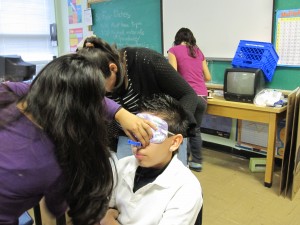(Break for a teaching tip for newbies. If classroom management has begun to seem tricky, this post may help.)
That Principal who threw out all the teachers’ desks in her Brooklyn school?* She had an attack of the wacky that day. Maybe she had been pushed over the edge, though, as she peered into classrooms and watched seated teachers whose students did not appear to be working. Students will take advantage of teachers who sit at desks for too long.

Your students need to know you are always available and always alert. (Or trying to be available and alert anyway. If I have ever had a teaching day when I fully hit this target, I’m sure I was too busy watching students to notice.) The learning that takes place in a classroom is related to the distance between you and your students. When you are readily available to students, learning will increase in subtle ways. The shy kid who will not raise a hand or walk to the front of the room may ask questions if you happen to be near her desk. The disruptive kid who wants to tell everyone about mom’s new boyfriend may get back to work if you are standing too near the gory details of her story. I recommend monitoring student progress by circulating throughout the room. Your desk should be a place to take attendance and set up instruction, but once class launches, you should move into the room and stand close to your kids.
During daily work, you can then give immediate feedback and catch misunderstandings before they become entrenched, repeated errors. During presentations, your nearby presence will increase attention. During testing, your wanderings will keep cell phones from sneaking out of pockets and secret lists from being stashed inside desks.
Wanderings also allow for those short chats that build relationships. A short, “Did your brother win his soccer game last night?” or “Does your ankle feel better?” can gain you good will that translates into better classroom behavior in the long-run. The key with these chats will be getting in and getting out. Classroom learning time cannot be sacrificed to lengthy social moments. One technique is to ask your personal question, listen attentively to the answer, maybe add a few comments, and then immediately ask another question related to the classwork.
“Six goals? Awesome. His team seems to be having a great year.” You point at the activity sheet. “Do you know what to do with the three-fourths in this denominator? Exactly. Great. Why did you decide to do that?”
Eduhonesty: By November, new teachers can feel neck deep in alligators. If you are feeling that way, ask colleagues for help. In any case, don’t let discouragement drive you toward your desk, towards separating yourself from the kids in the classroom. The more you connect with your kids, the easier classroom management will become.
*http://nycrubberroomreporter.blogspot.com/2015/10/ps-24-principal-donna-connelly-throws.html
